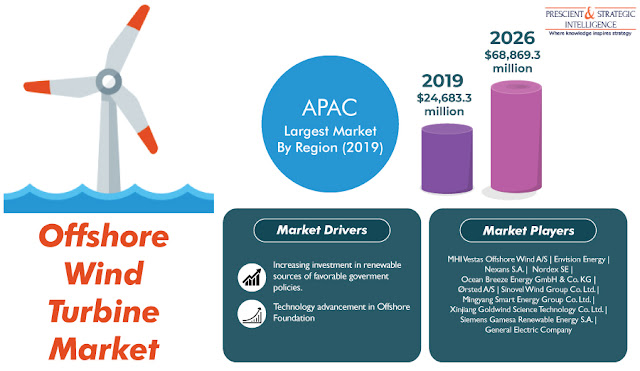
Shallow Waters: Viable Location for Offshore Wind Turbine Installation
Increasing awareness about the advantages of non-conventional energy sources has resulted in huge investments in the offshore wind energy sector. Moreover, the rapid depletion of fossil fuels and hazardous impacts of these conventional energy sources on the environment have encouraged more funding in the wend energy industry. Governments across the world are making investments in the renewable energy to cater to the future energy demands, while minimizing the conventional energy supply. These factors help the offshore wind turbine market to grow from $24,683.3 million in 2019 to $68,869.3 million by 2026.
Offshore wind turbines are mostly installed at shallow-water-depth area, as this region is more convenient for installing windmills, in comparison to deep-water region. Moreover, repair and maintenance of turbines in shallow water are easier, as compared to turbines in deep-water and transitional areas. Additionally, the development of cost-effective and reliable foundations for offshore wind turbines and bottom-fixed foundations, such as monopile, will boost the installation of windmills at the shallow-water-depth region, in the coming years.
Currently, the offshore wind turbine market offers turbines with varying capacities— up to 3 megawatt (MW), 3 MW–5 MW, and >5 MW. In the coming years, the installation of turbines with 3 MW–5 MW capacity will surpass the installation of up to 3 MW and >5 MW turbines. This is because 3 MW–5 MW turbines have high electricity generation capacity, owing to which energy companies will make huge investments for the construction of such plants. Moreover, low maintenance and operational costs of such turbines will result in their largescale installation.
Turbines of various capacities can either be fixed or kept afloat on the surface of water. Owing to the economic feasibility, easier commissioning, and decommissioning processes of fixed installations than the floating installations, public and private organizations prefer the former than the latter. The cables of the fixed wind plants remain in their position and are not deterred by weak waves and currents. Whereas, in the floating wind plants, cables are very vulnerable and any movement or breakage of wires will obstruct energy flow and generation.
Thus, the growing inclination toward renewable energy sources, on account of rising awareness about the benefits of green energy and drawbacks of fossil fuels, will accelerate the installation of wind turbine at offshore sites, worldwide.
Source: www.psmarketresearch.com
Comments